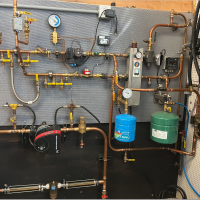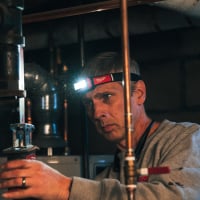Best Of
Re: Single Pipe Steam Boiler Replacement & Piping (Unusual header?) Advice for Amateur
So I have a solution for you to use in order to get proper estimates for your new boiler
On the left of the yellow line is what might have been there and why there is a capped off horizontal pipe on the header. On the right of the yellow line is an illustration of a replacement boiler with a drop header using both 2" risers from a boiler that has about 170,000 BTU Input with about 445 SqFt Net Steam Rating
The drop header will offer enough room to connect all 4 risers from the basement ceiling to the header with proper drainage to avoid noisy operation and promote proper condensate drainage to the equalizer.
Take note that the old original water line may have been about 20" higher on the original coal fired boiler that was there before your current boiler. The fact that there was so much wrong with the existing system when your first moved in tells us that the installer of that boiler may not have read TLAOS, and may be a contributing factor in the folks you purchased that home from to move out in the first place.
You now have a chance to make that system eve better!!!
Crown Boiler has a nice diagram with pipe sizes for your installer to use when designing your new system This diagram shows only one main riser. your installer will need to modify in order ot accommodate the 4 risers you have.
Re: Grunfos Domestic Hot Water Recirculation System
I damaged the threads on this valve so I cut it open to see the insides.
It is basically the same as a thermostatic mix valve. thermal motor a few springs. It has a tiny check, about 1/4" diameter and a small screen protecting it. I imagine those are the fail points from scale or dirt accumulation.
 hot_rod
hot_rod
Re: Single Pipe Steam Boiler Replacement & Piping (Unusual header?) Advice for Amateur
Suggest you get @Mad Dog_2 to consult. PM him
Re: Single Pipe Steam Boiler Replacement & Piping (Unusual header?) Advice for Amateur
I believe member @KarlW also lives in the Rochester area. He may have knowledge of a local contractor that worked out for him. You could PM him and see if he has any advice that will help you.
Re: Replace a Munchkin boiler before it fails, or keep it going?
the Navien option is a combination heat and hot water? I have a slight disdain for combis. They break more often. They are “less work” to install; i think some guys install them to save a little time. An opinion of epic proportion: real boiler guys don’t install combis.
Replace is? think of a 15 year old car. If it breaks down, do you have the energy to have a major repair done? Some people do. Some people toss it to the wind and buy a new car. There is no right or wrong answer. Older folks- maybe they don’t want the drama if it fails during a cold spell.
Arizona- what’s a cold spell over there? I guess “cold” is a relative term I suppose. Boiler seems big.
Navien: I’m a little irritated- a relative of an in-law switched from propane to natural gas (I know, normally the other way around). I offered to do the job. I had to spend an unbelievable amount of energy getting the correct part number for the orifice. When I finally got the part, the box said “high altitude” on it (I am a couple hundred feet above sea level) I had to spend even more energy trying to determine whether I had the correct part or not. I got conflicting information between the rep and Navien themselves. Never got an answer. That’s my two cents on Navien. The boiler runs safely but slightly out of spec on the o2 (small fraction of a point).
 GW
GW
Re: Single Pipe Steam Boiler Replacement & Piping (Unusual header?) Advice for Amateur
The near boiler piping is very wrong. it might happen to work ok now but it should be done correctly with the new boiler.
The header should be in the order of:
risers from boiler
risers from header to mains
equalizer
The header and risers from boiler size should be at minimum the size specified in the manual
Each main should connect separately to the header. If a main is counterflow it needs a drip down to below the water line before it connects to the header. each drip needs to have its own return connection below the water line.
The header shouldn't reduce in size on the horizontal so it doesn't trap water.
Run away from anyone that says to put in a boiler bigger than the connected edr. The nameplate edr has an extra 30% pickup factor subtracted from it so it is probably oversized a bit even if it matches the nameplate. Do not use anyone that suggests you should go bigger than the connected edr beyond what is the closest size.
If you have a main that is filling from a return, you have to figure out why that is possible, most likely returns from different mains that are connected above the water line. The returns from different mains must connect together below the water line. The most common reason for this is that a connection that was below the water line became above the water line when a boiler with a lower water line was installed. Also possible that whoever installed that boiler didn't understand why returns at the boiler needed to drop below the water line before connecting. The steam from the other main will come in to the main at the vent and close it, preventing the main from venting properly. It will eventually vent through the radiators but it will be slow to heat.
Your near boiler piping looks like they just hooked up whatever was closest wherever they could and didn't know what they are doing.
Re: Hydronic air handler not heating
UPDATE- @mattmia2 It worked out. Connected a hose to the valve on furnace side and turned it ON. It removed all the air from the coils. Heat is back On.
Thank you so much for your responses!
Re: Hydronic air handler not heating
depends on what isolation valves and boiler drains you have. you need to isolate so the flow from the municipal supply goes through the coil and out a drain. Ideally they would have put those near the domestic water heater so you can purge the coil without actually going to it.
Re: Remove PTAC unit for servicing
I got an AC tech (who I trust - he did work for me in the past) to quote me to clean the units.
He quoted me a fair price to clean on site. He's going to lay down a protective tarp, pull the units, spray the condenser and evaporator coils with appropriate cleaners and wash off with water.
For 25% more hes going to take the units to his shop, power wash off the dirt & grim. Clean the condenser and evaporator coils with appropriate cleaners and rinse off with water. Vacuum out the blower wheel. Return the units in the evening.
Seems like a no brainer to have him take it to his shop.
Re: Material price increases due to govermental tarrifs
WAIT! If memory serves, I thought it was the tariffed countries that paid the fees, Not consumers?
Regards,
RTW


